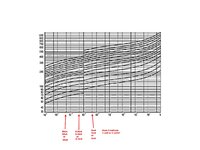xchcui
Member level 2
Hi.
When we connect a resistor in series with an LED to a DC voltage source, in order to determine the resistor value, we subtract the voltage drop of the LED from the voltage source and the result we divide by the current that we want to flow in the circuit.
If we change the resistor value, the current will decrease or increase, but the voltage drop on the LED will remain the same.
If I connect a varistor (MOV) in series with a resistor to a voltage source and change the resistor value,will the voltage drop on the varistor stay the same?
For example: If I connect to 500VDC source to a MOV-14D431R in series with a 70kΩ resistor (see picture,) the voltage drop on the varistor will be 430V (rated voltage,) the voltage drop on the resistor will be 70V, and the current will be 1mA, which fits the specifications.
What will be the voltage-drop on the MOV and on the resistor if i will change the resistor to 1.5MΩ?Will the voltage-drop on the MOV will still be 430V?
I attached a U-I graph that include the MOV-14D431R.
Thanks

.
When we connect a resistor in series with an LED to a DC voltage source, in order to determine the resistor value, we subtract the voltage drop of the LED from the voltage source and the result we divide by the current that we want to flow in the circuit.
If we change the resistor value, the current will decrease or increase, but the voltage drop on the LED will remain the same.
If I connect a varistor (MOV) in series with a resistor to a voltage source and change the resistor value,will the voltage drop on the varistor stay the same?
For example: If I connect to 500VDC source to a MOV-14D431R in series with a 70kΩ resistor (see picture,) the voltage drop on the varistor will be 430V (rated voltage,) the voltage drop on the resistor will be 70V, and the current will be 1mA, which fits the specifications.
What will be the voltage-drop on the MOV and on the resistor if i will change the resistor to 1.5MΩ?Will the voltage-drop on the MOV will still be 430V?
I attached a U-I graph that include the MOV-14D431R.
Thanks
.
